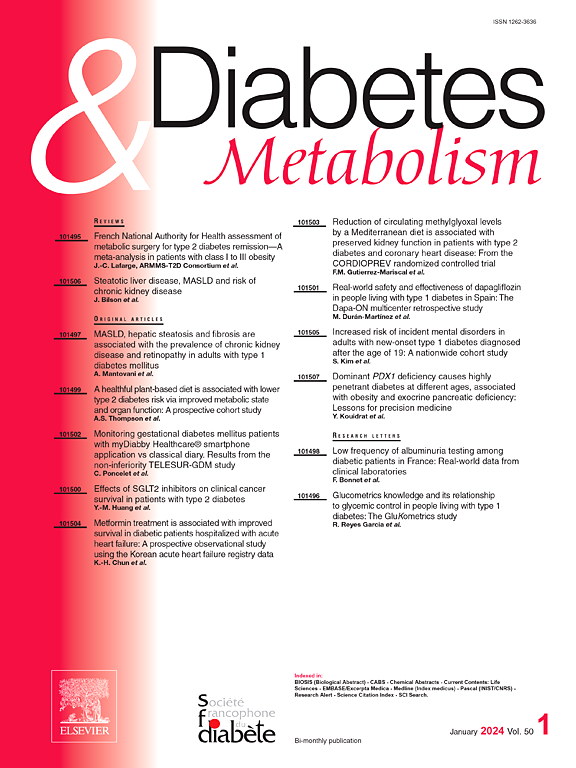Diabetic retinopathy remission in patients using an automated insulin delivery system: A prospective controlled study
IF 4.7
2区 医学
Q1 ENDOCRINOLOGY & METABOLISM
引用次数: 0
Abstract
Aims
Diabetic retinopathy (DR) is a complication of chronic hyperglycemia in people living with type 1 diabetes (PLWT1D). The use of automated insulin delivery (AID) systems may modify this course. In this prospective observational study, we evaluated whether the MiniMed 780G AID system was associated with remission or improvement in the severity of DR.
Methods
The study included PLWT1D with DR treated either with the AID system or with multiple daily insulin injections (MDI) combined with intermittent glucose monitoring. The follow-up period was two years. DR was graded annually, and HbA1c levels were recorded. Glucose monitoring parameters were also assessed to evaluate the impact of glucose ranges and variability on retinopathy. Group comparisons were performed using univariate and multivariate statistical analyses.
Results
DR remission occurred in 15/30 (50 %) participants treated with the AID system, compared with 0/30 (0 %) in the MDI group (P < 0.001). Improvement in DR stage was observed in 15/30 (50 %) participants in the AID group, compared with 2/30 (6.7 %) in the MDI group (P < 0.001). These outcomes were associated with lower HbA1c, reduced time above range (TAR), and a lower coefficient of variation (CV) in the remission group.
Conclusion
Remission or improvement of DR was observed in patients with type 1 diabetes treated with an AID system.
使用自动胰岛素输送系统的患者糖尿病视网膜病变缓解:一项前瞻性对照研究。
目的:。糖尿病视网膜病变(DR)是1型糖尿病(PLWT1D)患者慢性高血糖的并发症。使用自动胰岛素输送(AID)系统可能会改变这一过程。在这项前瞻性观察性研究中,我们评估了MiniMed 780G AID系统是否与dr严重程度的缓解或改善相关。-该研究包括PLWT1D合并DR,采用AID系统或每日多次胰岛素注射(MDI)联合间歇性血糖监测。随访期为两年。DR每年分级,记录HbA1c水平。葡萄糖监测参数也被评估,以评估血糖范围和变异性对视网膜病变的影响。采用单变量和多变量统计分析进行组间比较。结果:。-与MDI组的0/30(0%)相比,接受AID系统治疗的15/30(50%)患者出现了DR缓解(P < 0.001)。AID组15/30(50%)患者的DR期改善,而MDI组2/30(6.7%)患者的DR期改善(P < 0.001)。这些结果与缓解组较低的HbA1c、较短的高于范围时间(TAR)和较低的变异系数(CV)相关。结论:。使用AID系统治疗的1型糖尿病患者的DR得到缓解或改善。
本文章由计算机程序翻译,如有差异,请以英文原文为准。
求助全文
约1分钟内获得全文
求助全文
来源期刊

Diabetes & metabolism
医学-内分泌学与代谢
CiteScore
12.00
自引率
4.20%
发文量
86
审稿时长
13 days
期刊介绍:
A high quality scientific journal with an international readership
Official publication of the SFD, Diabetes & Metabolism, publishes high-quality papers by leading teams, forming a close link between hospital and research units. Diabetes & Metabolism is published in English language and is indexed in all major databases with its impact factor constantly progressing.
Diabetes & Metabolism contains original articles, short reports and comprehensive reviews.
 求助内容:
求助内容: 应助结果提醒方式:
应助结果提醒方式:


